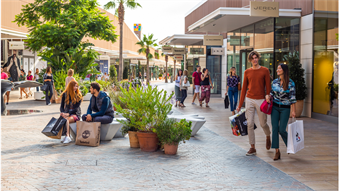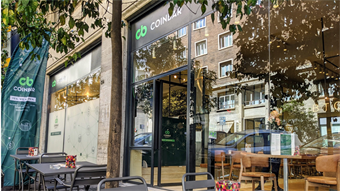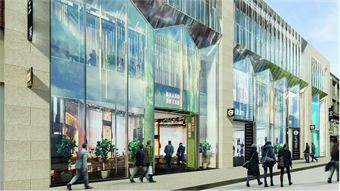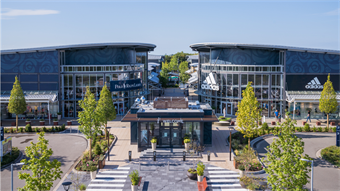German retail: building a future on solid traditions
- In Region in Focus
- 14:28, 03 december 2019
- 2224 Views
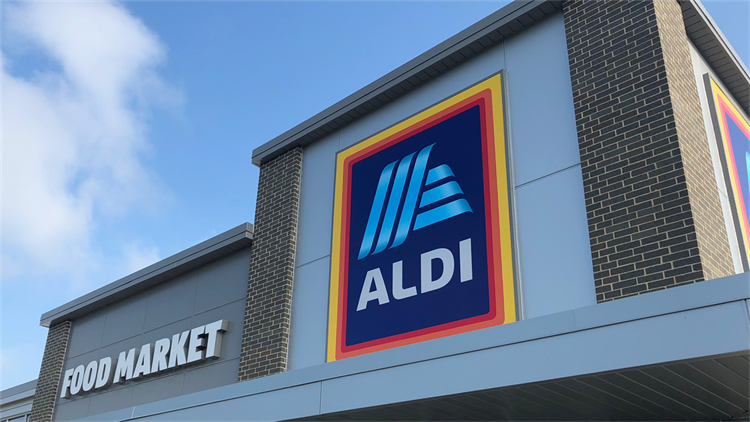
Some of the key offerings on the evolving German retail real estate smorgasbord are food retail, mixed use developments and prime high street in the country’s leading cities. But as Germany skirts recessionary pressures, there is little sign at this stage that retail’s favoured sub-sectors are feeling any negative impact.
Germany has a long-running love affair with bargain grocery shopping. In the home of uber-popular discounter brands like Aldi and Lidl, it’s a perfectly acceptable cultural norm that diverse households – ranging from the mass affluent to those living on more modest means – will fill the discounter aisles shopping for keenly priced groceries.
The nation’s bargain mindset and prevailing preference for cash or cash-backed retail spending tend to support a prudence or cautiousness that could act as a solid buffer. That is, going some way to protect the world’s fourth largest economy, and Europe’s strongest, from mounting concerns that it is entering into a recession.
But as trade tensions, automotive industry challenges and the long-playing Brexit saga fuel media headlines about a downturn in Germany, retail and retail real estate currently remain selectively positive about the outlook for their industries.
Readiness to spend
‘Germans have liquidity and they are willing to spend it, so that is one of the reasons why the retail market is still pretty strong,' says Frank Emmerich, head of retail, Germany at CBRE. ‘Germans love to pay with cash. But you can be sure that even if they pay by credit card, it will be backed up with cash.’
Consumer confidence may be buoyed by the fact that consumer savers do not earn interest on their deposits in Germany. However, Germans still have a relatively high savings ratio of 10% of their net income that they then spend, save or put by for rainy days.
Katharina von Schacky, Global Head of Shopping at Commerz Real, who used to work at John Lewis in the UK and has lived in Germany for the last eight years, cites distinct cultural differences.
‘The Brits like going to Marks & Spencer and Waitrose to buy convenience food items that cost quite a bit, but Germans would generally not do that,’ she says. ‘They don’t spend more than they have in their bank account. They would shop in Aldi and Rewe, for example, followed by a healthy food store. They have very different shopping behaviours.’
Strong appetite for food retail
Germany’s food retail sector is ‘saturated, highly consolidated and competitive’, according to analysis by the United States Department of Agriculture. And the top five retail groups – Edeka/Penny, Rewe/Netto, Schwarz (Lidl/ Kaufland), Aldi North/South, and Metro C+C/Real –together account for over 70% of the revenues in German food retail.
While Germans spend around 11% of their income on food, compared with about 13% in France but just over 9% in the UK, Germany has some of the lowest food prices in the European Union thanks to intense price competition among the discounters and supermarkets.
Food-anchored retail parks
The predictable and constant revenue streams in grocery retail have delivered a boon to the food-anchored retail park market, which has become a hot sub-sector over the last two years, according to retail estate professionals.
‘This year we are seeing the yields for food-anchored retail parks coming down to levels previously seen for core shopping centres,’ says Dirk Hoenig-Ohnsorg, head of retail investment, Germany at Colliers International.
‘Investors are looking for certainty and long leases anchored by grocery tenants – such as Edeka and Rewe – offering 10-15 years of fixed income in good locations, ideally complemented by a German drug store and a discounter,’ he says. ‘That’s what everyone is looking for.’
The German food retail market has attracted various French, UK and US food retail giants to try to carve out a position in the country, but the barriers to entry remain challenging. Namely, the cost of logistics and infrastructure as well as the intense pressure on margins.
Overall, there is no sign of demand cooling, especially for deals in the €20-30 mln range, according to Hoenig-Ohnsorg.
Another dynamic is the realisation that debt rates are not increasing. In the spring, there was some sentiment that interest rates could move out of the negative interest rate zone, making debt more expensive. Some institutional investors held back from buying core retail in the second quarter, says Hoenig-Ohnsorg.
'But during the summer, everyone accepted that interest rates would remain low and the bond market would not become more attractive to them, so they would have to continue investing in what is attractive to them, that is, core long-term real estate.'
Retail’s sweet spot
Pan-European investor Patrizia is still buying retail but as a house is very selective these days, says Daniel Hermann, Head of Fund Management Retail.
'The German market is not in such bad shape when compared with the bloodbath in UK retail in terms of rental values, valuations and investment activity,' he says. 'Germany is one of the stronger markets in continental Europe.'
Hermann says that Patrizia’s strategy focuses on the sub-sectors in retail which they consider to be “stable and sustainable”.
'We were never a buyer of shopping centres and high street retail in Germany, but since we have focused on retail on a wider scale since 2012 and 2013, this has always been the grocery side of retail.'
'The majority of our portfolio consists of German food-anchored retail park. This sub-asset class is very stable and is in high demand,' he says.
'There is sufficient liquidity in the German market and there are numerous parties that are interested in acquiring food-anchored retail assets because yields and risk profile are attractive compared with other asset classes. Quality assets with long leases are currently yielding between 6-7%.'
Jennifer Güleryüz, a senior consultant in Savills’s research team in Germany, thinks that the focus of online grocery retailers in cities will remain strong, but opportunities are also widespread. 'We do think that investment into discounters and supermarkets in the countryside is still a really good opportunity because it’s unlikely that we’ll see online food retailers serving the more rural parts of Germany.'
All of this interest in food retail is taking its toll on shopping centres that are feeling the pinch of growing online sales.
Shopping centre concerns
It’s clear that the pure shopping centre market is a tough one at the moment in Germany as it is in other countries.
'There is a limited demand among investors for core shopping centres right now compared to the peak of the market,' says Hoenig-Ohnsorg. 'We’re seeing a lot of interest in the core-plus and value-add areas. In particular, the sentiment is quite negative when it comes to fashion-anchored shopping centres.'
Typical in changing markets, there is seemingly limited willingness among core shopping centre owners to transact in a moderately corrected market. “We have a fair degree of uncertainty among investors today to acquire shopping centres at today’s rental levels,” says Hoenig-Ohnsorg. “The broad rent correction has not materialised in the shopping centre sector.”
In general though, the ongoing urbanisation trend in Germany is in many ways reshaping retailer’s development plans, not least because of limitations or bans on building retail-only schemes in cities.
Adding residential to the mix
When Aldi announced last year that it would be adding more than 2,000 apartments above stores in 30 locations, this move confirmed the now firmly established focus on mixed-used real estate. Aldi started its new approach with 200 residential units on the east side of Berlin in the hipster districts of Neukölln and Lichtenberg.
The mixed-use phenomenon combines retail, offices, kindergartens, food and beverage, medical centres and various facilities that meet local community needs. Stuttgart’s Konigsbaupassagen, for example, one of the biggest shopping centre deals in Germany in recent times, featured a 40% share of office space.
Commerz Real’s von Schacky agrees with the mixed-use approach. 'We are looking at assets that are multi-use or can be turned into multi-use,' she says. 'If you have an asset you can create your own footfall and offer a community of retail, residential, leisure and offices.'
'We don’t just look into one asset class but we use the breadth of knowledge of that we have in retail, hotels, housing, offices and F&B. We believe that it’s not about one single use – it’s about finding an attractive mix,' she says. 'People need to look at assets form a consumer perspective. If it’s likely that the consumer enjoys it, then it is likely to be a good investment.'
Putting consumers first translates into what Güleryüz describes as a 'one-stop shop', where retail blends with everything else people need in their daily lives. So does this trend translate into a bumper year for retail and mixed-use retail real estate? 'Although last year was our record year, we don’t think it will be the same volume this year,' says Güleryüz. 'But we do think that we’ll have a high volume of transactions this year including in retail.'
Urban growing pains
For retailers and property developers and investors, getting the blend of mixed-use schemes right can come with certain pressures – largely the results of overheating city centre living.
'There has been a tendency to convert retail to residential space, however this sector is also affected by the political uncertainty because of discussions limiting the growth of residential rents. In Berlin, for example, where there is a centre-left administration, the government has proposed a cap of eight euros per square metre per month, in any district of the city,' says Hoenig-Ohnsorg.
'This raises a question mark for certain business plans, which previously looked attractive, when it comes to converting the upper floors of retail locations,' he says.
Finding the construction firms to commit to new development also comes with challenges.
'I went to see probably the hugest development site in Hamburg recently and a year or two ago they couldn’t find a construction company, and there was a shortage of sand,' says von Schacky. 'In Dusseldorf, there is an empty lot for a building apartment because there is no one to do the construction. These are all knock-on effects of more people moving into city centres.'
Nevertheless, the biggest cities in Germany are maintaining thriving high street locations, despite the growing demand for sofa-based online shopping at home.
A flight to the big cities
All types of retailers want more of a share of the city centre, including those that have championed huge stores.
'Discounters are trying to get as close to their customers as possible including moving into the high street,' says Savills’s Güleryüz. 'Lidl opened in Munich with a much reduced footprint of 500 square metres on the prime high street where they can be as close to the office workers looking for convenience.'
While the dynamics in the huge-scale food retail market may have curtailed foreign players from entering Germany, the country’s decentralised structure offers opportunities on the high street.
There is no primary hub city in Germany like Paris, London or Madrid and Barcelona, with the possible exception of Berlin with its population of 3.5 million. Germany is more fragmented across seven cities: Berlin, Cologne, Dusseldorf, Frankfurt, Hamburg, Munich and Stuttgart – known as the Big 7. Add to that five smaller cities – Bremen, Dortmund, Leipzig, Hannover and Nuremberg.
'The major difference between Germany and other markets, such as France and the UK, the entry point tends to be opening a few stores in Paris and London, respectively, but there is a massive gap between those capital cities and other cities,' says CBREs’ Emmerich. 'But if you want to conquer the German market, you definitely have to open more than one store.'
Newcomers are still arriving
Emmerich says that over the last three to four years there have been 50 to 60 new entries into the German market a year, and this is the same level that he expects to see this year, buoyed by domestic demand and additional tourist spend.
But as in many European countries, it make less sense for retailers to spread their offering to too many locations. 'Behind the 12 main cities in Germany, there is a big gap,' says Emmerich. 'The reasons for that is that the big players like H&M and the Inditex group are all focused on the major cities.'
'In smaller cities with 100,000 inhabitants, there wouldn’t be one of the Inditex format present,' he says. 'If you live in one of these smaller cities, you are most likely to drive to the nearest big city where you’ll find the Inditex formats, Primark and H&M.'
'If one of those big retailers moves out, the other retailers can’t rock it. So this leads us to the point where the smaller cities become weaker,' he adds.
In any trend there is always the potential for a hidden gem. Commerz Real’s von Schacky agrees that there is a strong focus on the top-12 cities. 'But turning that around there are still so many cities in Germany that might offer better opportunities,' she says. 'Because people are not looking at them. So maybe assets are undervalued if they’re in a good location and there is a good opportunity.'


